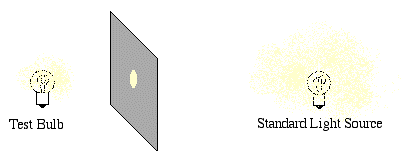
|
Hands-On-Physics
ELECTRICITY
|
Extensions
|
- Ready-Made Extension #3 -
|
Heating a Resistor
Some objects, like resistors you buy in an electronics store, have a nearly constant electrical resistance. Others have resistances that change. Temperature, moisture, and light can all effect resistance.What about light bulbs?
The general question of this investigation is:
"Is the resistance of a light bulb constant?" The quick answer is: "Probably not." Of course that leads to more questions; how can we check to see whether its is constant, and what might change it?
Use the LVPS and one of the light bulbs you used in the Core Project.
Start by investigating how the brightness of the bulb is related to voltage driving current through it. There's an old trick for studying light intensity. The trick is to compare the brightness of two light sources. You will need the test bulb whose brightness you will vary, and another light source for a constant standard. Plain candles were used as light standards for years, but you can probably do better. You will also need a plain piece of paper with a small grease spot in the center. A drop of vegetable oil will do it.

Figure E5
Measuring relative brightness
Move the paper back and forth between the two lights until it is evenly lit on both sides. You will be able to see that light doesn't shine through the grease spot at that point. It takes some human judgment, but so do all measurements. Practice helps. The ratio of the light intensities is the inverse of the ratio of the distances to the (balanced) paper screen with its grease spot. Report the results of this investigation with a graph. You don't know the absolute intensities, so just report the relative intensities of your test bulb.
You still don't know whether the resistance changes.
You have investigated how changing voltage changes
the brightness by estimating brightness (intensity) directly. However, you will have to
determine resistance indirectly by measuring the current.
(Ohm's law says that I = V / R, so R = V / I.) The bulb's resistance is proportional
to the voltage driving the current, but inversely proportional to the current.
To measure current you will need an ammeter.
If you don't have an ammeter, you can use your voltmeter to measure the current through a
known resistor connected in series with the bulb. A one Ohm resistor makes the conversion of
voltage (volts) to current (amps) very easy. Report the results of this investigation with a graph.
What caused the resistance to change?
Investigate other objects that have variable resistance:
- A thermistor is an object which changes its resistance when the temperature changes. A thermistor with a reasonable operation temperature range is Radio Shack # 271-110. Investigate the resistance of the thermistor with temperature change using a regular thermometer.
- Photoresistors change resistance when light shines on them.
One common type of photoresistor is made of cadmium sulfide ( CdS).
Radio Shack #276-1657 is a possibility.
Previous Page ||
Up a Level ||
Index ||
Next Page